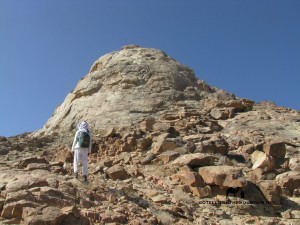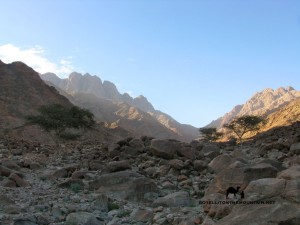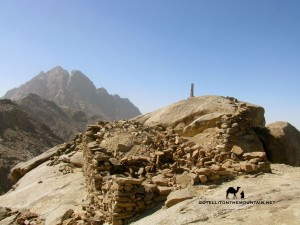August 2, 2014
Jebel Salla: the hidden gem
 Jebel Salla is one of the Sinai’s best hidden gems. I first saw it a few years ago, when I was sitting in Wadi Ajela, watching the afternoon shadows creep over the wadi. My guide, a Bedouin guy called Nasser, took out his binoculars, and pointed to a faraway mountain. As I sharpened the focus a beautiful peak came into view; a sugarloaf of white granite, towering up against a brilliant blue sky. It was covered in dark lines that looked man made, like walls or paths or something. Nasser, who’d been up before, said they were old ruins…
Jebel Salla is one of the Sinai’s best hidden gems. I first saw it a few years ago, when I was sitting in Wadi Ajela, watching the afternoon shadows creep over the wadi. My guide, a Bedouin guy called Nasser, took out his binoculars, and pointed to a faraway mountain. As I sharpened the focus a beautiful peak came into view; a sugarloaf of white granite, towering up against a brilliant blue sky. It was covered in dark lines that looked man made, like walls or paths or something. Nasser, who’d been up before, said they were old ruins…
I’ve seen a lot of ruins in the Sinai. Mostly in wadis. Or in basins. You do get ruins on summits. But they’re mostly small. Few cover entire peaks. None as dramatic as this, anyway. These were the most impossible set of ruins I’d seen anywhere in the Sinai. They looked amazing.
With a bit of time left before sunset, we went to climb it…
 We carried on up Wadi Ajela; a long wadi that runs down from the rugged slopes of Jebel Serbal, dotted with beautiful acacias. You can see it in that picture on the left. Further up, we turned off and began scrambling straight up to the mountain. Near the top we cut across its sheer cliffs on a wide ledge dotted with wild mountain shrubs, then clambered up to the top. The summit was marked by a tall standing stone. Below it, on the edge of a sweeping precipice, was a ruined church. Then, piled up on other parts of the peak, were, big banks of rocks. The dark lines we’d spied from below…
We carried on up Wadi Ajela; a long wadi that runs down from the rugged slopes of Jebel Serbal, dotted with beautiful acacias. You can see it in that picture on the left. Further up, we turned off and began scrambling straight up to the mountain. Near the top we cut across its sheer cliffs on a wide ledge dotted with wild mountain shrubs, then clambered up to the top. The summit was marked by a tall standing stone. Below it, on the edge of a sweeping precipice, was a ruined church. Then, piled up on other parts of the peak, were, big banks of rocks. The dark lines we’d spied from below…
 A British Ordnance Survey team climbed Jebel Salla in the 1860s – the first Europeans I know of who did it (and about the only ones since too) – and noted the church. But what about the other stuff? The big banks of rocks? Well, they reckoned Jebel Salla was a fortress peak; a place Christians, who lived in the nearby Wadi Feiran, retreated to in times of danger. The banks of stones were there – they said – to push down as missiles onto any assailants. I’m not an historian and they might well be right: but purely from a mountain point of view, I’m not 100% convinced, for the following reasons:
A British Ordnance Survey team climbed Jebel Salla in the 1860s – the first Europeans I know of who did it (and about the only ones since too) – and noted the church. But what about the other stuff? The big banks of rocks? Well, they reckoned Jebel Salla was a fortress peak; a place Christians, who lived in the nearby Wadi Feiran, retreated to in times of danger. The banks of stones were there – they said – to push down as missiles onto any assailants. I’m not an historian and they might well be right: but purely from a mountain point of view, I’m not 100% convinced, for the following reasons:
1. If you you hid here, you’d maroon yourself on a peak with no water. OK, you could take a supply. But it’d be a finite supply. Anybody wanting you off would just have to wait. Chucking rocks wouldn’t deter a proper attack.
2. More than that, if anybody DID have to run from danger, and if they WERE able to climb a tricky peak like this, there are much better places they could’ve gone; ones with water, escape routes etc. Early Christians knew these mountains…
Maybe I’m wrong, I don’t know. But the fortress theory just doesn’t add up to me.
Maybe those big banks of rocks were sitting platforms, or walkways; or just random rocks put down in shows of faith, pennance etc. Maybe they’re not supposed to be ANYTHING. When the Sinai gets better studied, historians will visit and settle the puzzle once and for all though…
 Anyway, whatever it was – ancient fortress peak or not – this is one of my favourite mountains in the Sinai; the best surviving testament to how well the early Christian communities of the Sinai got to know these desert highlands. Jebel Salla shows how curious early people here were about the mountains and how hard they worked to develop them. Today, Jebel Salla remains virtually off the map. Most visitors who come to Wadi Feiran go to Jebel Serbal, the great jewel in Feiran’s crown. Take it from me though, a trip to Jebel Salla is never time wasted (you can even do it at the end of Jebel Serbal). You won’t just climb a brilliant peak. You’ll discover the relics of a lost world…
Anyway, whatever it was – ancient fortress peak or not – this is one of my favourite mountains in the Sinai; the best surviving testament to how well the early Christian communities of the Sinai got to know these desert highlands. Jebel Salla shows how curious early people here were about the mountains and how hard they worked to develop them. Today, Jebel Salla remains virtually off the map. Most visitors who come to Wadi Feiran go to Jebel Serbal, the great jewel in Feiran’s crown. Take it from me though, a trip to Jebel Salla is never time wasted (you can even do it at the end of Jebel Serbal). You won’t just climb a brilliant peak. You’ll discover the relics of a lost world…